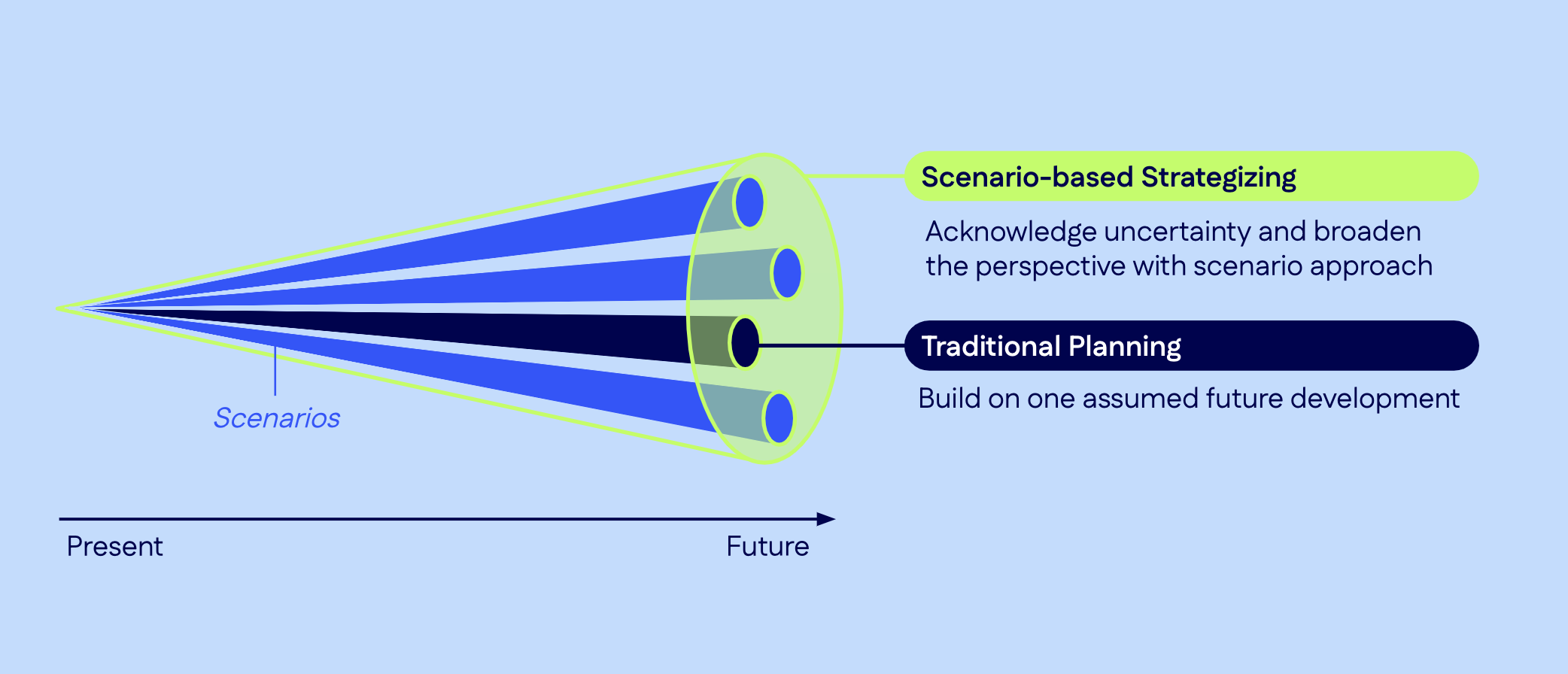Interview: Exploring the Power of Scenario-Based Strategizing

Interview with Sebastian Knab, Partner at Bluemorrow
Sebastian, can you explain what Scenario-Based Strategizing is and why it’s particularly relevant today?
Sebastian Knab: Absolutely. Scenario-Based Strategizing is about preparing for multiple plausible futures rather than betting on a single predicted path. In today's world - marked by rapid technological change, geopolitical uncertainty, and pressing sustainability challenges - traditional, single-future strategies often fall short.
Scenario-based approaches enable companies to look at a range of possible outcomes, identifying potential risks and opportunities they might miss otherwise. For example, think of how companies like Shell in the 1970s used scenarios to anticipate oil price shocks, which gave them an edge during crises. Today, the stakes are even higher. With climate change, technological disruption, and the AI revolution, organizations need to build foresight into their core strategy.
That’s exactly what our foresight-driven strategy service aims to support, helping businesses remain adaptive and resilient, no matter what future unfolds.
Why do you think some companies struggle with scenario-based planning?
Sebastian Knab: A big part of the challenge is that scenario-based planning requires a shift from focusing only on immediate goals to preparing for uncertainties, and that isn’t always intuitive for companies accustomed to stability. Many organizations are geared toward optimizing for a single, expected future, so adopting a mindset that actively anticipates multiple potential paths can be uncomfortable.
Additionally, developing effective scenarios demands a range of insights - from technology to regulatory changes to customer behavior. Without that, the process can feel overwhelming. At Bluemorrow, we guide clients through a structured methodology to make it accessible. Companies that embrace this mindset early tend to be more agile and better prepared for disruption (something we also explore in our article on 6 key foresight insights).
How does Scenario-Based Strategizing work in practice? Could you walk us through the key steps?
Sebastian Knab: Certainly. The process has two main streams, scenario and strategy development, and an integration step to bring both together.
- The scenario stream starts with identifying key drivers of change - factors like regulatory shifts, emerging technologies, or consumer preferences that are likely to impact the business environment. We often use a STEEP framework, which considers Social, Technological, Economic, Environmental, and Political factors, to organize these insights. After that, we develop a range of plausible scenarios based on these drivers.
- The strategy stream starts with identifying major strategic challenges that need to be addressed as well as multiple possible responses to each. We then combine different responses to develop alternative, consistent strategies. Finally, we evaluate these strategies in light of the scenarios.
This way, we can see not only which strategies would perform best under specific conditions but also identify those that are resilient across multiple possible futures. Once evaluated and a future-proof strategy has been decided upon, making it actionable by defining and implementing required strategic initiatives is essential for long-term success.
This structured approach is a core part of our future strategy offering, helping clients move from vision to decision.

Could you share an example where this approach has proven particularly effective?
Sebastian Knab: One that showcases the power of the approach perfectly is a project we did with a large airline just before the COVID-19 pandemic. As we all know, the pandemic hit airlines particularly hard, grounding 80-90% of all flights within a few days. I was often asked whether we had anticipated the pandemic in our project. The answer is ‘no’, but we did have a scenario in which the airline would stop operating short-haul flights within Europe due to severe environmental regulations.
While we hadn’t anticipated the pandemic, the effects of it on the industry were very close to our scenario and consequently, the action plans we had developed helped the airline through the pandemic very well. That’s the essence of foresight: not predicting, but preparing. Identifying plausible shifts early, whether through trend scanning or opportunity identification, can help organizations stay ahead of change.
How do you ensure that scenario-based strategies translate into actionable results for clients?
Sebastian Knab: That’s crucial. The power of Scenario-Based Strategizing isn’t just in imagining the future but in creating a roadmap to work with it. We identify specific strategic initiatives and line them up on a timeline leveraging synergies across them. In addition, we integrate foresight directly into the client's continuous strategic and innovation processes. For example, we identify specific “signposts” or “tipping points” - observable trends or events that indicate which scenario might be unfolding.
This way, clients know when to pivot or double down on certain initiatives. It’s about keeping foresight connected to the day-to-day and aligning it with real, measurable actions.

What role does AI play in scenario-based strategies?
Sebastian Knab: AI has become a central element in most scenario-planning discussions, and for good reason. The rapid advancements in machine learning, automation, and data-driven decision-making means that businesses must factor AI into their strategies if they want to remain relevant.
Scenario-based strategies allow us to anticipate various technological, regulatory, and social scenarios that could influence AI adoption. For instance, by considering multiple outcomes, companies can design products, operations, and business models that are resilient in both highly regulated AI landscapes and more permissive ones, depending on how things evolve.
On the other hand, AI is also reshaping how we conduct foresight itself. From real-time trend analysis to simulating market dynamics, it’s becoming a core tool in the strategist’s kit—something we actively explore in our AI for innovation work.
What advice would you give companies just starting with Scenario-Based Strategizing?
Sebastian Knab:
Start by embracing the mindset that no future is certain. That shift is essential. It’s also important to involve a range of perspectives in the process - different departments, stakeholders, and even external experts.
At Bluemorrow, we often find that the most valuable insights come from collaboration across functions, particularly when exploring complex challenges like sustainability or digital transformation. Lastly, don’t hesitate to start small. Even a smaller, hands-on scenario exercise can provide valuable insights and trigger aha-moments that will make a real difference in your strategic planning.
Finally, Sebastian, how do you see the field of strategic foresight evolving in the next decade?
Sebastian Knab: I believe foresight will move from the periphery to the core of business strategy. It will be embedded not just in strategy, but in venture building, operations, and leadership development.
As organizations recognize the importance of being future-ready, they’ll move beyond isolated foresight projects and develop internal foresight functions. We’re already seeing this shift with companies building dedicated foresight teams, which is something we support at Bluemorrow as part of our service. I also think advances in data analytics and AI will enhance foresight by enabling real-time scenario updates.
The goal is to keep foresight relevant and adaptive, ensuring that companies are prepared for a world that will only become more complex, interconnected and uncertain.




